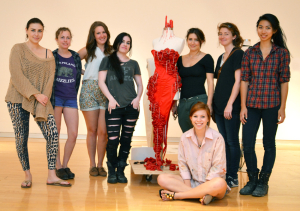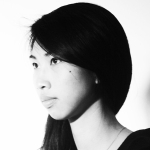
The Scripps College Senior Art Exhibition reveals many things, including the passions and secrets of budding artists every spring. Just don’t bother asking its age.
Sure, there’s anecdotal evidence of its longevity – alumnae swear they participated in similarly-titled events as early as 1958 – but it has no official birth certificate. Files maintained by the College contain exhibit announcements and little else; the records are, as Sally Preston Swan Librarian Judy Harvey Sahak ’64 notes, “all loosey goosey.”
 Not that mysterious origins detract in any way from the Senior Art Exhibition’s vibrant history. Each annual event features provocative work from Scripps (and occasionally other consortium) students at the Ruth Chandler Williamson Gallery, with each exhibit meticulously designed by the artist and defended in a manner very similar to how a doctoral candidate defends her thesis. This year’s exhibition, “Comparisons are Odious,” is the end result of 10 seniors working in concert with one another.
Not that mysterious origins detract in any way from the Senior Art Exhibition’s vibrant history. Each annual event features provocative work from Scripps (and occasionally other consortium) students at the Ruth Chandler Williamson Gallery, with each exhibit meticulously designed by the artist and defended in a manner very similar to how a doctoral candidate defends her thesis. This year’s exhibition, “Comparisons are Odious,” is the end result of 10 seniors working in concert with one another.
“Art faculty are very involved and committed to the process,” says Susan Rankaitis, Fletcher Jones Chair in Studio Art. “It’s the highlight of our academic year.”
Exhibits routinely challenge the status quo, whether the subject is positive psychological theory, contemporary transhumanism, or the link between art, fashion, and identity. Many times, the piece extends beyond the gallery’s walls: the Arizona desert was faithfully recreated in 2010, and Lili Salzberg’s upcoming installation dominates the center of the gallery floor.
“I’m doing 12 million different activities,” says Krista Sharpe ’12 of her animated video Awakening. “I believe the best art is created by the marriage of skills and interesting ideas. You develop your technical abilities in order to express yourself, but you must have interesting concepts to express.”
“The Senior Art Exhibition was one of my first opportunities to show my work to the public,” says artist Monica Furmanski ’96. “For others to see your work and to experience it is both nerve-wracking and exhilarating; the concepts I work with now are directly related to the work I created at Scripps.”
The result is an experience as timeless as the exhibition itself. “[Professor of art] Ken Gonzales-Day often reminds students that art alumae come to the opening of the show,” says Rankaitis. “The alums challenge them; it’s like an initiation rite into the art world for our seniors.”
The 2012 Senior Art Exhibition opens Friday, April 27. For more information, contact Susan Rankaitis or the Ruth Chandler Williamson Gallery.
Artist Profiles
Lily Burgess
 “My work explores personal experiences with gratitude through the materiality of sheer fabric installations,” Lily says. “Rooted in positive psychological theory, this work aims to express the effect of thankfulness beyond its basic daily application.”
“My work explores personal experiences with gratitude through the materiality of sheer fabric installations,” Lily says. “Rooted in positive psychological theory, this work aims to express the effect of thankfulness beyond its basic daily application.”
Lauren Escobar
 “I am making a series of collector’s plates that survey erotic art through the ages, from ancient Greece and Pompeii till today,” says Lauren. “I have re-appropriated images from around the world and from various civilizations in history in order to shed light on the distinct and fascinating role that sexuality plays in art, a topic that unites humans not just across borders but through the ages. A combination of images both digitally and hand drawn were made into ceramic decals then fired into the plates.”
“I am making a series of collector’s plates that survey erotic art through the ages, from ancient Greece and Pompeii till today,” says Lauren. “I have re-appropriated images from around the world and from various civilizations in history in order to shed light on the distinct and fascinating role that sexuality plays in art, a topic that unites humans not just across borders but through the ages. A combination of images both digitally and hand drawn were made into ceramic decals then fired into the plates.”
Vivian Haesloop
 “My project,” says Vivian, “is an exploration of the apartment complex I live in and its inhabitants through the medium of painting and drawing. I aim to assume the role of artist as ethnographer and create a visual mapping of the space and those who occupy it.”
“My project,” says Vivian, “is an exploration of the apartment complex I live in and its inhabitants through the medium of painting and drawing. I aim to assume the role of artist as ethnographer and create a visual mapping of the space and those who occupy it.”
Katherine Hegarty
 Katherine describes her exhibit as “three handmade, artist designed dresses that discuss the links between art and fashion as well as present the conceptualization of identity as a merger of both fields.”
Katherine describes her exhibit as “three handmade, artist designed dresses that discuss the links between art and fashion as well as present the conceptualization of identity as a merger of both fields.”
Asia Morris
 “My desire to create this vision in real life is also a desire to explore the methods of my thinking process, meaning what steps I habitually take to create,” says Asia. “My work has Post-Minimal qualities, like a return to the glorification of the artist’s presence in her work.
“My desire to create this vision in real life is also a desire to explore the methods of my thinking process, meaning what steps I habitually take to create,” says Asia. “My work has Post-Minimal qualities, like a return to the glorification of the artist’s presence in her work.
“In my thesis I proposed a Re-emergent Post-Minimalist movement exists today, where the work focuses on craftsmanship, the material, the creative process, and the ability of the piece to maintain an ephemeral, yet universal connection to life. My work is about exploring my vision and how it can exist in my viewers’ minds.”
Allison Perry
“My thesis explores female participation and representation in contemporary video games and investigates the stigma many women seem to have against video games,” says Allison. “The art portion of my thesis focuses on female characters in games, celebrating the progress made towards strong, equal, and believable representation though large, traditional-style portraiture.”
> “My work seeks to create an ironic language that draws on traditional representations of female identity but examines them through a critical lens, exposing the absurdity of the connotations about femininity maintained in these archetypes,” says Michelle. “I hope to convey a level of syncretism that combines critique and reinvention, draws on religious, historical and psychological ideologies, and calls for a celebration of the female form and experience.”
“My work seeks to create an ironic language that draws on traditional representations of female identity but examines them through a critical lens, exposing the absurdity of the connotations about femininity maintained in these archetypes,” says Michelle. “I hope to convey a level of syncretism that combines critique and reinvention, draws on religious, historical and psychological ideologies, and calls for a celebration of the female form and experience.”
Lili Salzberg
 “My thesis focuses on obsession with form,” says Lili. “My specific obsession is with the form of the coffee filter and how it can be transformed to create an environment which overwhelms those who experience it. My goal is to create an environment that conveys my obsession with the form and allows the viewer to feel what I feel.”
“My thesis focuses on obsession with form,” says Lili. “My specific obsession is with the form of the coffee filter and how it can be transformed to create an environment which overwhelms those who experience it. My goal is to create an environment that conveys my obsession with the form and allows the viewer to feel what I feel.”
Krista Sharpe
“The moving drawings of William Kentridge and the works of contemporary transhumanist thinkers inspire my project. Pictures are taken as I draw and then reassembled in a film to create the appearance of movement emerging from a still charcoal drawing,” says Krista.
Tiffany Yau
 “This project presents the matter of managing archives of objective data as portraits of subjective experiences of an individual and a community,” says Tiffany. “A static, material graph of an individual’s vital stats indicate personal experience in opposition to a dynamic, evolving map of a virtual social network constructed based on algorithmic functions.”
“This project presents the matter of managing archives of objective data as portraits of subjective experiences of an individual and a community,” says Tiffany. “A static, material graph of an individual’s vital stats indicate personal experience in opposition to a dynamic, evolving map of a virtual social network constructed based on algorithmic functions.”

